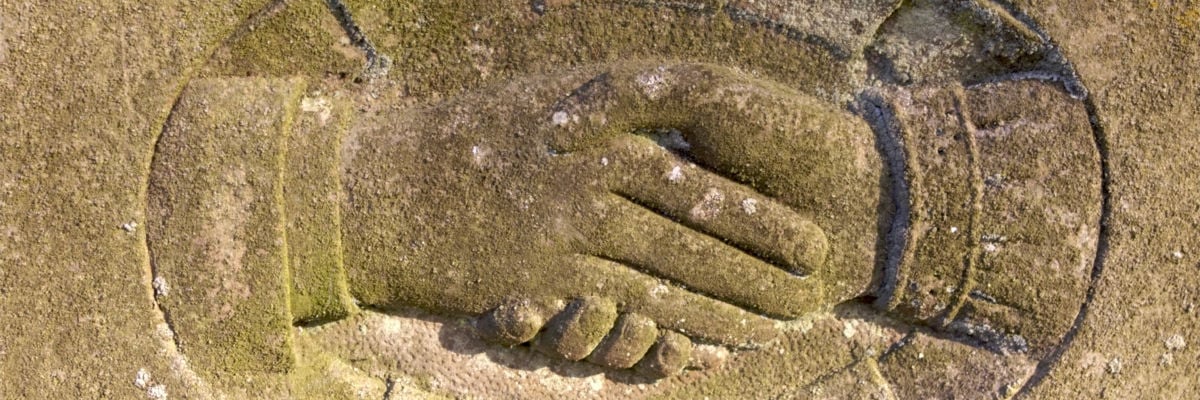
The Sign of Peace, the handshake that takes place at Sunday Mass between the Our Father and the Agnus Dei (Lamb of God) before Holy Communion, is sometimes a source of friction and confusion.
The friction derives from the experience of it getting out of hand—being disruptive and even an intrusion. These problems were serious enough to raise the question, at the 2009 Synod of Bishops in in Rome, of moving the Sign of Peace to before the Offertory. Here, I want to shed some light on the meaning of the rite, which helps to put the question into some context.
The “Pax” (“peace”), or kiss of peace, is a very ancient rite—so ancient, in fact, that the Irish word for “kiss,” póg, derives from the Latin “pax” thanks to this ceremony. Confusingly, however, in the Latin Church, the Pax was historically found in two different places. In France and other places, it took place before the Offertory; in Africa and Rome, it took place before Holy Communion, after the Our Father. The Church’s modern rites, both traditional and post-Vatican II, use the second location for the Pax, and this makes a difference regarding its meaning.
Liturgical commentators regarded the exchange of Peace before the Offertory as a symbol of mutual affection, connected with Matthew 5:23-4: “If therefore thou offer thy gift at the altar, and there thou remember that thy brother hath any thing against thee; leave there thy offering before the altar, and go first to be reconciled to thy brother: and then coming thou shalt offer thy gift.” The Offertory is literally the offering of the “gift” to God, so this is our chance to renew our charity, to make ourselves more worthy of making this offering.
After the Offertory and the Consecration, the Pax was said by Pope Innocent III to be a “seal” of what had gone before, like an “amen.” However, it also reminds us of what we have just prayed in the Our Father: “And forgive us our debts, as we also forgive our debtors” (Matt. 6:12).
In addition, with the consecrated host then present upon the altar, the Pax gained another kind of significance. As the rite developed, before starting the exchange of peace, the priest kissed the altar next to the consecrated host. In some early versions of this, he actually kissed the host, or the crucifix. Then he turned to give the Pax to the assistant clergy, who gave it to the people. The Pax, then, is the peace of Christ, represented by the altar and by the crucifix, and really present in the consecrated host.
A liturgical rite can have several meanings, and some can be stressed more than others. Having the Pax after the consecration, and with the preliminary kissing of the altar, downplays the aspect of mutual love and reconciliation and plays up the aspect of receiving peace from Christ: “Peace I leave with you, my peace I give unto you” (John 14:27).
This is reinforced further by the parallel between the Pax and the blessing at the end of Mass, which is preceded by the priest kissing the altar—again, to indicate that the blessing comes not from the priest as an individual, but from Christ. Something similar happens at the beginning of Mass, when the priest kisses the altar before turning to the people (if he needs to) and saying, “The Lord be with you.” (In the pre-Vatican II Mass, he kisses the altar and says this no fewer than four times during the course of Mass.)
Looked at in this context, the Pax is not so much an opportunity to make friends as it is a blessing. A blessing, emanating from the consecrated host, has a special importance for those who are not receiving Holy Communion, and of course, for much of the history of the Church, most of the faithful did not receive Communion at most of the Masses they attended.
If we think of the Pax as a blessing, it matters less if the people take part directly in the ceremony. This has its usefulness, as their participation created a number of problems over the centuries. A stylized kiss or embrace was not thought, by our predecessors of ancient times, as suitable to be given between men and women, who used to sit in different parts of church (usually women on the left as you face the altar). One solution, developed in England, was the use of an object, the Paxbrede, which was kissed by one person after another. This underlined the passage of the Peace from the altar to the people, but not only did it take some time, but it also led to disputes about who should kiss it first. Finally—and this seems to have finished the practice off in most places—there were concerns about hygiene. Today, in the traditional liturgy, you will find the Paxbrede used only in certain places, notably in Spain and by the Dominicans.
In the post-Vatican II liturgical reform, there was a desire to include the people more closely in the ceremony, which revived these dilemmas. At least in principle, a simultaneous handshake is quick, is hygienic, and can be done between men and women. Its weakness lies in undermining the connection between the peace exchanged among the people with the peace that comes from Christ, really present on the altar. To minimize disruption, the celebrant is actually forbidden from leaving the sanctuary to give the Peace to the congregation (General Instruction of the Roman Missal 82, 152), though this rule is often ignored.
As already noted, the rite is most often criticized for causing disruption, which is indeed regrettable. The decision of Pope Benedict XVI in 2007 not to move it from before Holy Communion to before the Offertory, despite this, underlines the remaining importance of seeing the Peace as something emanating from Christ—however many, or few, of our fellow Catholics we actually shake hands with.



